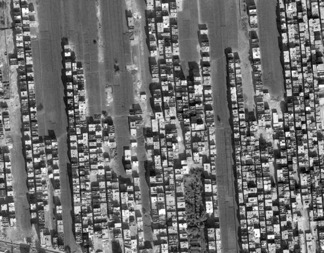By Rosalie Lovy
Questions
- How does real estate development vary over the large area of the GCR (Greater Cairo Region?)
- How does tourism influence real estate markets?
- How is the government managing population pressures through real estate development?
- What external actors (including buyers, developers, designers, and others) have influence in this market?
- How have cultural and historical changes affected what is seen as desirable in the real estate market?
Discussion
The real estate market in Cairo is geared towards development and construction rather than leveraging existing valuable real estate assets. Within the market to construct, sell, and rent new buildings there are two axes of developers. One axis, between high-end and low-end markets, separates legitimate development from informal or illegal practices. The second, between revitalization of downtown Cairo and the development of surrounding desert/agricultural land, explains the differences in core and peripheral patterns of development. This separates real estate into four categories along these two axes: low-end downtown, low-end peripheral, high-end downtown, and high-end peripheral, each of which has unique defining elements.
Low-income development of the downtown areas has been largely unsuccessful in Cairo despite the 3 million vacant apartments in the downtown area. Elshahed argues that this is due in part to the various heritage associations which protect large buildings with historic architectural heritage from being demolished for apartment buildings or divided into affordable spaces (Elshahed, 2015). This can be overcome by using corrupt zoning practices in some cases, but it is difficult to compromise with authorities on the construction of modern buildings in the Islamic and Medieval quarters as a smaller-scale developer. In addition, inheritance laws allow ownership of a building across many generations. These inherited plots often pass to the state if the family falls into financial trouble and rarely become available for development. Thus, while there is ample vacant space in the downtown neighborhoods for the construction of accessible housing, this is rarely achieved (Elshahed, 2015).
High-end development in downtown areas is equally complex. There is strong state support for development in these areas, particularly for tourism. Barthel and Vignal argue that though heritage preservation laws still apply, larger scale tourist-oriented projects have been successful, in particular in areas of the city along the Nile, which has historically been less developed and thus is less protected (Barthel and Vignal, 2014). However, this downtown riverside area is not considered the most desirable address for local wealthy Cairenes, with satellite developments seen as more desirable for their security and amenities. In light of this, efforts are being made to revitalize the area. For example, the Al Ismailia Real Estate Development company aims to purchase 10% of the building stake in the Islamic quarter (Ismailia) with the aim of creating not only residential properties but also utility infrastructure and social/commercial space. Such developments seek to undo some of the loss of cultural value in these areas since the end of the colonial period. Certain sections of the European quarter exemplify this loss. Where large cinemas, theaters, and cafes used to line streets such as Talaat Harb, now fast food chains and convenience stores dominate the street. These amenities are not attractive to high-end buyers and have decentralized culture in the city. Cinemas and theaters, in particular, have been frequently transformed into shopping malls due to their large size (Elshahed, 2015). This vacuum of cultural content has defied traditional models of gentrification in the area. Artists who have taken advantage of the vacant spaces for galleries and ateliers have failed to prompt increased real estate values or repopulation of the vacated centers. In other cities, the arrival of artists and other cultural growth has increased the desirability of certain neighborhoods. In Cairo’s case, the artists have not heralded gentrification and the downtown areas have remained mostly vacant. In downtown Cairo, the most profitable real estate development remains linked to tourism and not long-term residents. Hotels such as the Nile Hilton, constructed as a symbol of the modernity of the post-colonial regime, continue to be developed and built, as tourism becomes increasingly important to Cairo’s economy (Elsheshtawny, 2014).
This is linked to Cairo 2050, the government’s visionary plan for the redevelopment of large swaths of the city to help manage population growth and draw international visitors. The project draws heavily upon urban projects in Dubai and other Gulf states, for its financing model as well as its creative inspiration. It mirrors other post-Arab Spring revitalization projects such as those in Tunis and Casablanca, which took direct cues from building projects in Dubai and other cities for parks, residences, shopping centers, and other “wow-factor” features (Barthel and Vignal, 2014). Cairo 2050 currently faces funding problems for its ambitious plans. There is also a new level of international scrutiny on such projects following the failures of certain projects in Dubai as well as concern about the lack of accommodation for an adequate number of the city’s poor. In decades prior, such massive investment in the downtown area might have been viewed by international observers as a positive move for the country. However, given previous cases in which projects failed to produce social benefits, this sentiment has changed somewhat.
Similar concerns are now being raised about the high-income developments in satellite areas. These developments consist largely of gated communities with extravagant amenities. The goal of many developers, again with strong Gulf representation, is to create insular communities largely detached from Cairo. Adham claims that this trend of segregated luxury communities is not new to Cairo, as such neighborhoods existed under colonial rule. The modern developments began in earnest in the 1980s with the economic growth of the Middle East. As inequality has deepened, the demand has continued to rise (Adham, 2005). Only since the 2008 financial crisis has international funding for these projects decreased (Barthel and Vignal, 2014). These complexes, such as the Bahgat Group’s Dreamland development, contain gyms, schools, theme parks, golf courses, and other facilities which remove most pressures to engage with the outside world. The large size of the individual homes in them contributes to population densities far below those in low income areas. This is especially true in formerly public agricultural lands redeveloped as private farmland plots—often styled as “European Farms,” with marketing materials comparing them to the Bavarian, French, or Italian countryside and enjoying the same amenities as suburban gated communities. In these areas, however, no more than 2% of a plot can be used for residential property (Adham, 2005). This aims to help protect public agricultural land from informal development, which is rampant in these areas. The government-owned fields are common targets for illegal residential development. In privatizing these areas and marketing them to high-end buyers who can hire laborers to work the fields and also enjoy space to build luxury homes, the government hopes that the private owner’s interest in protecting their property against illegal development will help curb the loss of agricultural acreage. These homes are often occupied by a combination of Egyptian and expatriate residents, who can use resources from wealthier countries to afford this level of luxury. In recent years, concern over the environmental impact of these settlements has been raised, largely over their very high use of water to maintain landscaped golf courses, pools, and cooling systems (Barthel and Vignal, 2014).
There is a historic explanation for the preference for these new developments over downtown apartments. As opposed to cities with extremely valuable real estate in their core, such as Paris and New York, the downtown areas of Cairo are often associated with Westernization and the oppression of the colonial period. This architecture and the specific sites of former colonial buildings retain a stigma as backwards and non-Egyptian (Elshahed, 2015). The targeting of colonial sites, such as the famous Old Shepheard’s Hotel, in the 23 July movement of the 1950s that toppled colonial rule exemplifies this feeling. After the political change, development shifted towards the Nile and away from the Medieval and Europeanized districts (Elsheshtawny, 2014). This contributes to the contemporary divide between tourist-focused real estate downtown and resident-geared development in the peripheral areas of the city.
Low-end development of satellite areas is more difficult to measure due to the largely informal and illegal nature of these transactions. The government has attempted to establish low-income housing projects but has failed to draw many tenants. This is due in part to the fact that these settlements are located farther from the city and thus represent a sacrifice of proximity to the livelihoods of many people. In addition, the informal market consistently beats the government in terms of cost efficiency. In the popular informal developments constructed on former agricultural land, the plots are naturally divided into narrow and regular strips following to field layouts. Social capital and expedited construction thanks to bribery means that these buildings are built faster and rented at lower rates than the public projects, though they often are of low quality and unsafe. In addition, this speculative market has been more profitable than speculation in legitimate markets (Tarbush, 2012). A single well-positioned person buying large swathes of land, usually government agricultural plots not approved for housing or not legitimately owned by the seller, stands to make a great deal more by developing it than a real estate investor in legitimate apartments. The government’s response to this problem has been to instate legal financing with very low down payments and government-provided loans in order to compete with the informal market and increase legal housing stock. This means that there is very little incentive to create profitable real estate, since land is bought so cheaply and the government is the only party with a stake in the property, rather than a system involving other financial backers. Thus, the success of informal real estate development is in some ways not only a product of desperation but a rational reading of housing markets (Tarbush, 2012).

Figure 2: Informal residential development on agricultural land following the striped pattern of former cultivation rows.
Overall, real estate markets in Cairo vary greatly based on their intended buyers as well as their location. The slowing of foreign investment as well as the impracticality of government plans may have serious ramifications for the development of the downtown areas in the future. As the population continues to grow, the government must work to legitimize real estate development to better preserve its agricultural areas and provide services to its poor, as well as to better control the environmental impact of luxury development.
Sources
Adham, Khaled. “Globalization, Neoliberalism, and New Spaces of Capital in Cairo.” Traditional Dwellings and Settlements Review 17, No. 1 (2005): 19-32.
Barthel, Pierre-Arnaud, and Leïla Vignal. “Arab Mediterranean Megaprojects after the ‘Spring’: Business as Usual or a New Beginning?” Built Environment 40, No. 1 (2014): 52-71.
Elshahed, Mohamed. “The Prospects of Gentrification in Downtown Cairo: Artists, Private Investment and the Neglectful State.” In Global Gentrifications: Uneven Development and Displacement, edited By Loretta Lees, Shin Hyun Bang, And Ernesto López-Morales, 121-42. Bristol, UK; Chicago, Il: Bristol University Press, 2015.
Elsheshtawny, Yasser. “Urban Transformations: The Great Cairo Fire and the Founding of a Modern Capital, 1952-1970.” Built Environment (1978-) 40, No. 3 (2014): 408-25.
Tarbush, Nada. “Cairo 2050: Urban Dream or Modernist Delusion?” Journal of International Affairs 65, No. 2 (2012): 171-186.


